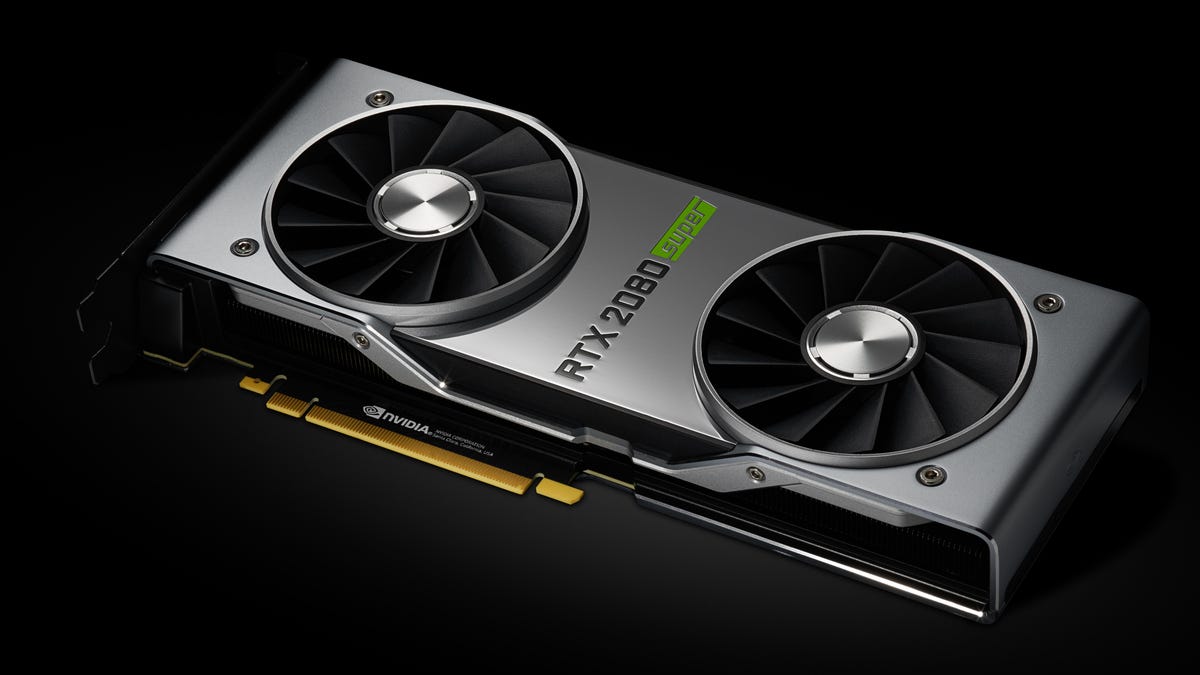Nvidia's GeForce RTX Super line boosts 2060, 2070 and 2080 for same $$
Aiming to up sales of its GeForce RTX graphics cards, Nvidia's new "Super" versions offer improved specs for the same price as the older models.

Hopefully, the new design improves heat dissipation as well.
I hope you didn't just buy a new Nvidia GeForce RTX graphics card. If you did, you might be somewhat peeved about the company releasing replacements for several models before the old ones have even celebrated their first birthday. The three new "Super" versions -- the GeForce RTX 2080 Super, 2070 Super and 2060 Super -- slip into the line between the 2080 Ti on the high end and 2060 on the low, replacing the 2080 and 2070.
The new Super cards essentially bump up the specs from their predecessors to deliver a little performance lift for the same money -- Nvidia claims 15 to 20% on average -- albeit at the expense of increased power draw. The 2060 and 2070 Super will ship next week (maybe in time for some Amazon Prime Day lovin'!), while the 2080 Super is expected closer to the end of the month. Nvidia didn't provide many details about the latter's specifications.
New GeForce RTX lineup
| GeForce RTX 2060 | GeForce RTX 2060 Super | GeForce RTX 2070 | GeForce RTX 2070 Super | GeForce RTX 2080 | GeForce RTX 2080 Super | GeForce RTX 2080 Ti | |
|---|---|---|---|---|---|---|---|
| Memory (GDDR6) | 6GB | 8GB | 8GB | 8GB | 11GB | n/a | 11GB |
| Memory bandwidth (GB/sec) | 336 | 448 | 448 | 448 | 616 | n/a | 616 |
| GPU clock speed (MHz, base/boost) | 1,365/1,680 | 1,470/1,560 | 1,410/1,620 | 1,605/1,770 | 1,515/1,710 | n/a | 1,350/1,545 |
| Memory data rate/Interface | 14Gbps/192 bit | 14Gbps/256 bit | 14Gbps/256 bit | 14Gbps/256 bit | 14Gbps/256 bit | 15.5Gbps/n/a | 14Gbps/352 bit |
| Texture fill rate (gigatexels per sec) | 201.6 | 224.4 | 233.3 | 325.7 | 278.8 | n/a | 367.2 |
| Ray tracing (gigarays per sec) | 5 | 6 | 6 | 7 | 8 | n/a | 8 |
| CUDA cores | 1,920 | 2,176 | 2,304 | 2,560 | 2,944 | n/a | 4,352 |
| Streaming multiprocessors | 30 | 34 | 36 | 40 | 46 | n/a | 68 |
| FP32 (teraflops) | 6.5 | 7.2 | 7.5 | 9.1 | 80.5 | n/a | 107.6 |
| TGP (watts) | 160 | 175 | 175 | 215 | 215 | n/a | 250 |
| Price | $349 | $399 | $499 | $499 | $699 | $699 | $999 |
The RTX 2060 Super receives the biggest relative improvements over its older version, including an increase of 2GB GDDR6 VRAM from 6GB to 8GB and joining the rest of the family with a 256-bit memory interface. Frankly, the 2060 should probably have had those specs to begin with. If it had, it probably wouldn't have been in performance limbo, unworthy of the money for its barely-worth-it RTX support.
Adoption of Nvidia's proprietary RTX extensions for real-time ray-traced rendering, lighting effects (global illumination, shadows and so on), and AI-accelerated and improved scaling (DLSS) across games has been a bit slow, though that's not very surprising in an industry where software seriously lags behind hardware for all but the highest-profile games and publishers. And for the games that have incorporated it, turning it on, especially for all the cards below the 2080 Ti, has often resulted in a performance hit that's just not worth the pretty penny.
So Nvidia's move to shore up the performance of the middle of its RTX line -- which hopefully will make the performance dips at the lower end of the line more palatable, if not obliterate them -- is both unsurprising and welcome. That is, unless you dropped $400 or more on an RTX 2060 only to find it didn't run your favorite games sufficiently faster than a cheaper GTX card to justify the price, and now find yourself without the funds to buy the card you thought you were getting in the first place.
The increase in memory bandwidth and CUDA cores should deliver enough speed or quality improvements on older and less fancy games to soften the pain of waiting for ray-traced titles like Cyberpunk: 2077, Watch Dogs: Legion and Atomic Heart to appear.
Given the mere $50 price difference between the entry-level 2060 and the supered-up version, you might wonder why Nvidia kept the older version in the line. That's possibly because the lower power requirements and even just that $50 difference make it an attractive option for retailers selling midrange gaming desktops that need to make a specific price target to lure you in -- and upsell you to the Super.

